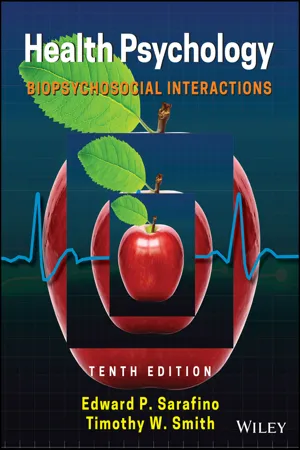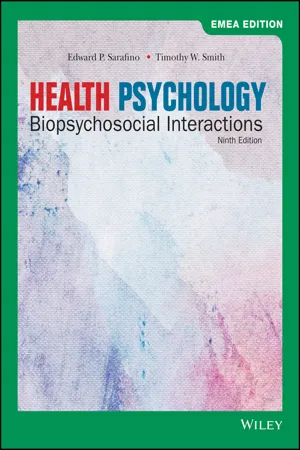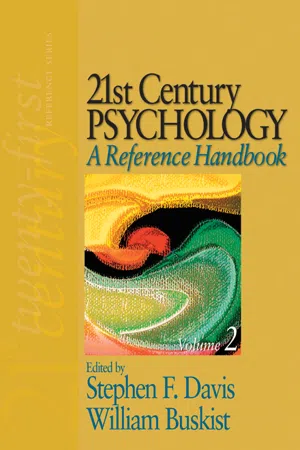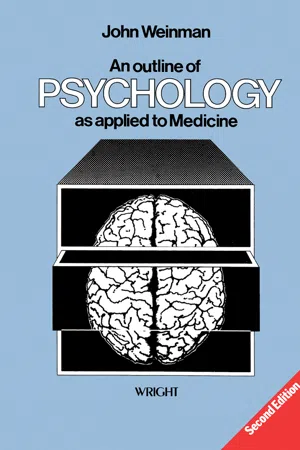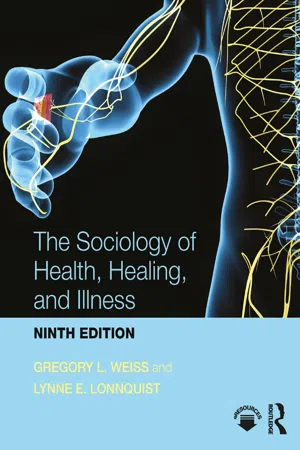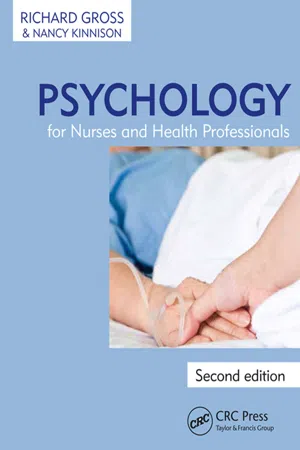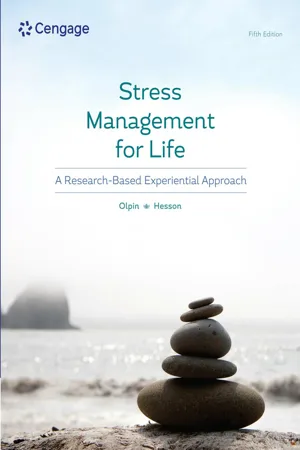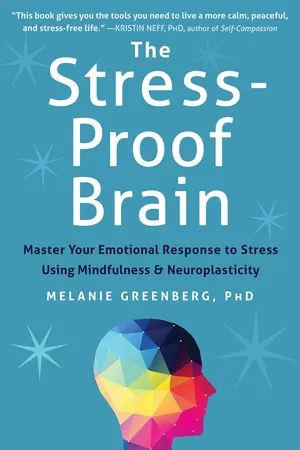Psychology
Stress Definition
Stress is a physiological and psychological response to a perceived threat or challenge. It can be triggered by various factors, such as environmental pressures, personal expectations, or life changes. Stress can manifest as physical, emotional, or behavioral symptoms and may have both short-term and long-term effects on an individual's well-being.
Written by Perlego with AI-assistance
Related key terms
1 of 5
11 Key excerpts on "Stress Definition"
- eBook - PDF
Health Psychology
Biopsychosocial Interactions
- Edward P. Sarafino, Timothy W. Smith(Authors)
- 2021(Publication Date)
- Wiley(Publisher)
Usually the statement means they feel unable to deal with the demands of their environment, and they feel tense and uncomfortable. Because of the pervasiveness and com- monality of these experiences in our lives, you might expect that defining the concept of stress would be simple. But it isn’t. Let’s see how psychologists have conceptualized stress and what the prevailing defini- tion is today. WHAT IS STRESS? The condition of stress has two components: physical, involving direct material or bodily challenge, and psy- chological, involving how individuals perceive circum- stances in their lives (Lovallo, 2005). These components can be examined in three ways (Dougall & Baum, 2012). One approach focuses on the environment: stress is seen as a stimulus, as when we have a demanding job or experience severe pain from arthritis or a death in the family. Physically or psychologically challenging events or circumstances are called stressors. The second approach treats stress as a response, focusing on peo- ple’s reactions to stressors. We see an example of this approach when people use the word stress to refer to their state of tension. Our responses can be psycho- logical, such as your thoughts and emotions when you “feel nervous,” and physiological, as when your heart pounds, your mouth goes dry, and you perspire. The psychological and physiological response to a stressor is called strain. The third approach describes stress as a process that includes stressors and strains, but adds an important dimension: the relationship between the person and environment (Lazarus, 1999; Lazarus & Folkman, 1984). This process involves continuous interactions and adjustments—called transactions—with the person and environment each affecting and being affected by the other. - eBook - PDF
Health Psychology
Biopsychosocial Interactions
- Edward P. Sarafino, Timothy W. Smith(Authors)
- 2020(Publication Date)
- Wiley(Publisher)
Usually the statement means they feel unable to deal with the demands of their environment, and they feel tense and uncomfortable. Because of the pervasiveness and commonality of these experiences in our lives, you might expect that defining the concept of stress would be simple. But it isn’t. Let’s see how psychologists have conceptualized stress and what the prevailing definition is today. WHAT IS STRESS? The condition of stress has two components: physical, involving direct material or bodily challenge, and psycho- logical, involving how individuals perceive circumstances in their lives (Lovallo, 2005). These components can be examined in three ways (Dougall & Baum, 2012). One approach focuses on the environment: stress is seen as a stimulus, as when we have a demanding job or experience severe pain from arthritis or a death in the family. Physically or psychologically challenging events or cir- cumstances are called stressors. The second approach treats stress as a response, focusing on people’s reactions to stressors. We see an example of this approach when people use the word stress to refer to their state of tension. Our responses can be psychological, such as your thoughts and emotions when you “feel nervous,” Mauro Fermariello/Photo Researchers This man’s face reveals that he appraises the pain in his chest as stressful. and physiological, as when your heart pounds, your mouth goes dry, and you perspire. The psychological and physiological response to a stressor is called strain. The third approach describes stress as a process that includes stressors and strains, but adds an impor- tant dimension: the relationship between the person and environment (Lazarus, 1999; Lazarus & Folkman, 1984). This process involves continuous interactions and adjustments—called transactions—with the person and environment each affecting and being affected by the other. - Stephen F. Davis, William Buskist, Stephen F. Davis, William F. Buskist(Authors)
- 2007(Publication Date)
- SAGE Publications, Inc(Publisher)
INTRODUCTION According to Richard Lazarus (1999), early models of psy-chological stress adopted analogies from engineering and physics. Robert Hooke, a 17th-century physicist-biologist, discussed how external force (load) applied to a particular area of a structure (stress) creates deformation (strain) of that structure. Over time, the use of the terms stress and strain came to apply to models of psychological stress, where the stress stimulus (or stressor) is the external force and the stress response is the body’s reaction to the stressor. Historically, researchers have focused mainly on the stress-ors, the physiological response to the stressors, or more recently, the complex interaction between them and how cognitive factors such as appraisal affect this relationship. In the first approach, stress is viewed in terms of the external events to which we must adapt. These stimuli could be anything ranging from catastrophic events that affect large numbers of people (natural disasters, terrorist acts), to the major life events of an individual (marriage, unemployment), to the daily hassles of life (traffic, shop-ping). The second way stress has been defined is in terms of the response to these events. In this case, there is no prediction about what kind of stimulus could be a stressor because virtually any stimulus could be. Rather, the focus is on physiological changes that occur, such as changes in 176 • HEALTH, STRESS, AND COPING heart rate or stress hormone levels. However, one major problem of this definition is being able to distinguish an increase in heart rate due to psychological stress from an increase due to exercise. In this model, both would be considered stressful. Limiting the definition of stress to either the stimulus or the response fails to take into account the relationship between them and the individual differences that medi-ate this relationship.- John Weinman(Author)
- 2013(Publication Date)
- Butterworth-Heinemann(Publisher)
Thus it can be used to describe various unpleasant situations or events which are considered to be stressful. Alternatively, it may be used to describe the behavioural or physiological responses which occur when an individual is confronted by an unpleasant situation or stressor. A third view of stress regards it as a reflection of an incompatibility between the individual and his or her environment. This last approach combines elements of the first two since 55 56 An outline of psychology stress is thought to arise from the inappropriate or inadequate responses to certain environmental demands. Each of these three approaches is now considered. i. Stress as a stimulus Stimulus-based approaches to stress are concerned with identifying aspects of the environment which have an adverse effect on the individual. This view tends to be a rather simple mechanistic one which attempts to equate human stress with definitions arising from physics or engineering. Metals can withstand a certain amount of stress but they all have a threshold or 'yield point' and if this is exceeded then permanent damage will result. Correspondingly, stimulus-based definitions of human stress incorporate the idea that people also have a fixed capacity to withstand stress and if this is exceeded then adverse changes will occur. This type of approach is therefore concerned with identifying stressful situations and determining how and why they have adverse effects on psychologi-cal and physiological processes. Many of these studies have focused on work environments and on various physical characteristics (e.g. ambient noise, heat, etc.) as well as job demands. Situations where work is under constant time pressure and where a large amount of information has to be processed are generally rated as stressful. Monotony and isolation also have unpleasant effects and situations in which the individual has little control over events are also found to be rated as stressful.- No longer available |Learn more
Organizational Stress
A Review and Critique of Theory, Research, and Applications
- Cary L. Cooper, Philip J. Dewe, Michael P. O'Driscoll, Michael P. O′Driscoll(Authors)
- 2001(Publication Date)
- SAGE Publications, Inc(Publisher)
As has already been noted, stress has been defined as a stimulus, a response, or the result of an interaction between the two, with the interaction described in terms of some imbalance between the person and the environment (Cox, 1978). As empirical knowledge has developed, particularly that surrounding the person-environment (P-E) interaction, researchers have considered the nature of that interaction and, more importantly, the psychological processes through which it takes place (Dewe, 1992). From this debate has emerged a belief that traditional approaches to defining stress (i.e., stimulus, response, interaction) have, by directing attention toward external events, diverted researchers away from considering the processes within the individual through which such events are appraised (Duckworth, 1986). This is not to say that such ideas have gone unresearched or that earlier definitional approaches are necessarily inadequate. However, as knowledge and understanding of stimulus, response, and interaction definitions and their associated meaning have advanced, the debate about how stress should be defined has shifted ground. Rather than singling out and focusing separately on the different elements of the stress process, we suggest that it is now time to examine more comprehensively the nature of that process itself and to integrate stimulus and response definitions within an overall conceptual framework that acknowledges the dynamic linkages between all elements of the stress process. Contemporary views on how stress should be defined require researchers to think of stress as being relational (Lazarus & Launier, 1978): the result of a transaction between the individual and the environment (Lazarus, 1990). The transactional approach draws researchers toward identifying those processes that link the individual to the environment - eBook - ePub
- Gregory L. Weiss(Author)
- 2017(Publication Date)
- Routledge(Publisher)
stress as “a state of imbalance within a person, elicited by an actual or perceived disparity between environmental demands and the person’s capacity to cope with these demands.” Stress occurs in response to “strainful and threatening circumstances in the environment” and has clearer boundaries than states such as anxiety or depression, which are more global, more diffuse, and may exist “even in the absence of specific threats” (Pearlin and Schooler, 1978:4).HISTORICAL DEVELOPMENT OF THE STRESS CONCEPT
The idea of stress has existed for centuries. As discussed in Chapter 2 , such historical luminaries as Hippocrates believed in the humoral theory of illness—that positive health results from a mind and body in harmony—and this is perhaps the earliest characterization of an individual who is not “stressed out.” Hippocrates’ belief in the self-healing powers of the body is also consistent with an understanding of the body’s adaptation to stress.Historical records indicate that in the fourteenth century the term was equated with hardship and affliction, and in nineteenth-century medicine, stress was cited as a cause of ill health, as many diseases were attributed by physicians to conditions of “melancholia,” “grief,” or “despair.” Clearly, by the 1800s, there was widespread recognition of the link between mind and body.Ironically, Pasteur’s demonstration that bacteria cause disease (the germ theory of disease) led many physicians and medical researchers to confine their attention to such germ-caused diseases in the hope of finding specific disease etiology and appropriate “magic bullets.” In doing so, many of them abandoned interest in the less concrete areas of attitudes and emotions.Walter Cannon and Hans Selye
Early in the twentieth century, Walter Cannon, an American physiologist, used the term homeostasis - eBook - PDF
- A. Weinberg, C. Cooper(Authors)
- 2011(Publication Date)
- Palgrave Macmillan(Publisher)
39 CHAPTER 3 The natur e of st r ess in turbul ent times Si nce gai ni ng popular ity i n the 1970s and 1980s, the con- cept ‘stress’ has achieved the status of an overused term. It is readi ly identi f iable as a state of bei ng which is usually less than desi rable and describes our state of physical and psy- chological arousal when pressures bear down on both our dai ly existence and our sense of well-bei ng. In the context of turbulent ti mes, this is highly relevant to many of us. The f i rst part of this chapter wi ll clar i fy what is meant by stress, highl ighti ng the emotional and bodi ly experiences which are consistent with it as well as the i mpact on organi zations and i ndividuals. Defining ‘stress’ We all have a working definition of the term ‘stress’ which we probably use to describe what is happening when pressure affects us. This is useful insofar as it helps us convey to oth- ers that things are not going well, but the meaning of the term reaches its limits when we want to describe anything more detailed that that. To complicate matters, ‘stress’ is often used to describe both the process of things ‘not going well’, as well as the outcomes for our health. To avoid potential confusion, we will refer to sources of pressure as ‘stressors’ and the con- sequences for our well-being as ‘strain’, including acute (short- lived) and chronic (long-term) outcomes. For a detailed history 40 Stress in turbulent times of the background to research into stress, the reader is referred to Stress: A Brief History , by Cary Cooper and Philip Dewe. In order to set the largely negative experience of stress in con- text, it is worth recogni zing that, for many of us, the existence of a spur to get the best out of ourselves, is sometimes a useful thing. In this way, a deadline might enhance our motivation to complete a task, or the presence of high levels of threat can contribute to improved performance in sporting or other con- texts. - Richard Gross, Nancy Kinnison(Authors)
- 2017(Publication Date)
- Routledge(Publisher)
75 Stress: Definitions and causes 4 Introduction and overview According to Bartlett (1998), … the notion that stress is bad for you and can make you ill has become a modern cultural truism. However, there is also a significant body of research evidence which lends support to this idea … The study of stress must … be central to … health psychology, which con-cerns, at its most basic level, the role of psychosocial processes in health and disease. Definitions of stress fall into three categories (Bartlett, 1998; Goetsch and Fuller, 1995): 1. Stress as a stimulus 2. Stress as a response 3. Stress as an interaction between an organism and its environment. In turn, this classification corresponds very closely to the three models of stress identified by Cox (1978): 1. The engineering model , which is mainly concerned with the question ‘what causes stress?’ 2. The physiological model , which is concerned with ‘what are the effects of stress?’ 3. The transactional model , which is concerned with both the aforementioned questions plus ‘how do we cope with stress?’ Although stressors are faced by everyone (especially, perhaps, those living in constantly changing Western cultures), some face greater demands than others. As a group, patients (both in and out of hospital) face sources of stress that they did not have to deal with before becoming ill. Similarly, while all 76 Stress: Definitions and causes occupations are stressful, some are more stressful than others. Several studies have suggested that health workers experience more stress than comparable groups of non-health workers (Jones, 1995). In terms of Warr’s (1987) vita-min model, which identifies several environmental factors that affect mental health, nurses and other health professionals are likely to suffer from organ-isational stressors that are common to many other occupations (such as lack of clarity, conflicting roles, work overload and lack of control).- eBook - PDF
Stress Management for Life
A Research-Based Experiential Approach
- Michael Olpin, Margie Hesson, Michael Olpin(Authors)
- 2020(Publication Date)
- Cengage Learning EMEA(Publisher)
The Science of Stress 3 chapter © Jeff Cameron Collingwood/Shutterstock.com To understand the stress response, we must possess a fundamental knowledge not only of psychology but of physiology as well. —George Everly Why do I need to understand the science of stress? I just want to learn to relax. What is the purpose of the fight- or-flight response? Is the physiological response to stress different in males and females? What really happens in my body when I feel stress? Study of this chapter will enable you to do the following: 3.1 Describe the human fight-or-flight response. 3.2 List the physiological changes associated with the stress response. 3.3 Name the stages of the general adaptation syndrome. 3.4 Explain how the science of stress relates to stress management and prevention. Learning Objectives Copyright 2021 Cengage Learning. All Rights Reserved. May not be copied, scanned, or duplicated, in whole or in part. Due to electronic rights, some third party content may be suppressed from the eBook and/or eChapter(s). Editorial review has deemed that any suppressed content does not materially affect the overall learning experience. Cengage Learning reserves the right to remove additional content at any time if subsequent rights restrictions require it. 3.2 Stress and the Big Bear 31 3.1 The Science of Stress Just mention stress and everyone groans. Too much stress just does not feel right. The story of stress is a long one, beginning with our ancestors many generations ago. Throughout his- tory, people have experienced stress related to everything from war to poverty to disease to money. The quest for understanding stress has resulted in a surge of research during the past half-century. More is known about the physiology and psychology of stress than ever before. This chapter and the next provide a scientific foundation built on principles, theories, and models of stress to help you understand the physiology and psychology of stress. - eBook - PDF
Psychology and the Challenges of Life
Adjustment and Growth
- Spencer A. Rathus, Jeffrey S. Nevid(Authors)
- 2019(Publication Date)
- Wiley(Publisher)
Some Chinese municipalities have designated women-only cars to cope with the problem, but men usually crowd in anyway— especially during rush hour. Review Sentence Completion 1. Daily are regularly occurring annoyances or events that threaten our well-being. 2. Life , even pleasant ones, are stressful because they require adjustment. 3. Chemical messengers in the body that help block pain signals are called . 4. The emotional state of occurs when a person’s attempts to accomplish a goal are thwarted. The Body’s Response to Stress 97 5. The feeling of being pulled in two or more directions by opposing motives is called . 6. behavior is characterized by a sense of time urgency, com- petitiveness, and aggressiveness. 7. Disasters (increase or decrease?) our sense of control over our lives. 8. High levels of heat tend to (increase or decrease?) aggressiveness. Think About It What hassles do you encounter on a daily basis? Do you see them as impossible obstacles or as opportunities to solve problems and grow as a person? The Body’s Response to Stress Stress is more than a psychological event; it is more than “knowing” it is there; it is more than “feeling” pushed and pulled. Stress also has clear effects on the body. The body under per- sistent stress is apparently much like a clock with an alarm system that does not shut off until its energy has been depleted. The field of health psychology studies the relationships between psychological factors, such as stress, and physical health. The General Adaptation Syndrome Hans Selye (1976), who was playfully dubbed “Dr. Stress,” observed that the body’s response to different stressors shows certain similarities, whether the stressor is a bacterial invasion, per- ceived danger, or a major life change. For this reason, he labeled this response the general adaptation syndrome (GAS). The GAS is a cluster of bodily changes that occur in three stages: an alarm stage, a resistance stage, and an exhaustion stage. - eBook - PDF
- Greenberg, Melanie(Authors)
- 2017(Publication Date)
- New Harbinger Publications(Publisher)
PART 1 Understanding Your Stress CHAPTER 1 Your Brain’s Stress Response Stress is a fact of life, and it’s here to stay. Loss, conflict, uncertainty, loneliness, health challenges, competition, deadlines, and financial strain are things we all experience. Your brain’s hardwired response to stress, however, is meant to protect you from immediate physical danger . Much of our physiological response to stress was laid down through thousands of years of evolution. A programmed stress response helped our ancestors take fast physical action to keep from being eaten by lions or failing to compete for food. In that sense, it was certainly a good thing! Unfortunately, the same programmed stress response isn’t too good at helping us deal with modern-day stresses such as paying the bills, dealing with a grumpy boss or a sick family member, and fighting with our loved ones. These situations don’t generally call for physical action—they require understanding people’s intentions; dealing with failure, loss, or uncertainty; solving logistical problems; or sustaining mental effort. They require us to process lots of information in a short time, juggle competing priorities, and deal with a rapidly changing world. If you’re feeling stressed, it may be because your brain is oversensitive to danger. Your brain may be signaling that situations such as those listed above are threats to your survival and readying you for extreme action that isn’t necessary or appropriate to your day-to- day challenges (Sapolsky 2004). 10 Stress-Proof Brain The skills you’ll learn in this book will help you calm down your brain’s automatic stress reaction, along with excess anxiety and anger, so that the more rational parts of your brain have time to get on board and formulate a more mindful response. With repeated practice of the exercises in this book, your brain will learn to manage stress effectively so that life stressors become manageable challenges rather than insur- mountable threats.
Index pages curate the most relevant extracts from our library of academic textbooks. They’ve been created using an in-house natural language model (NLM), each adding context and meaning to key research topics.
